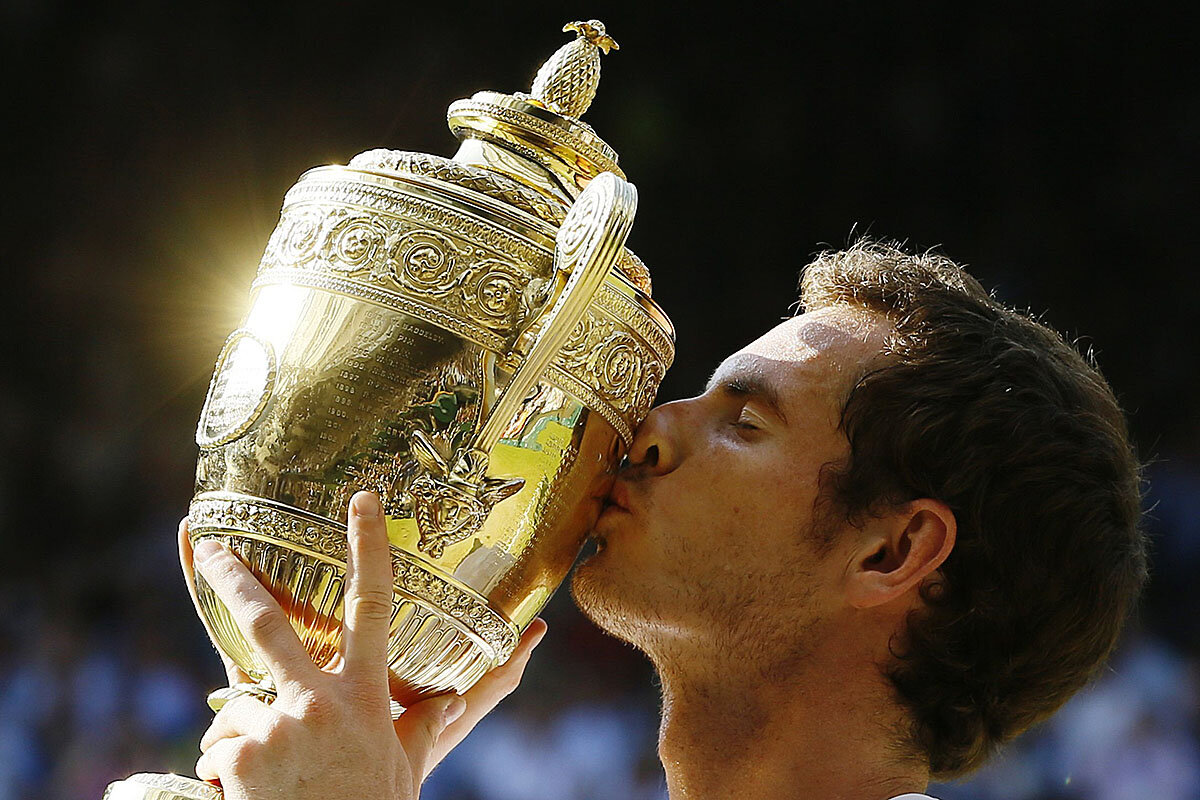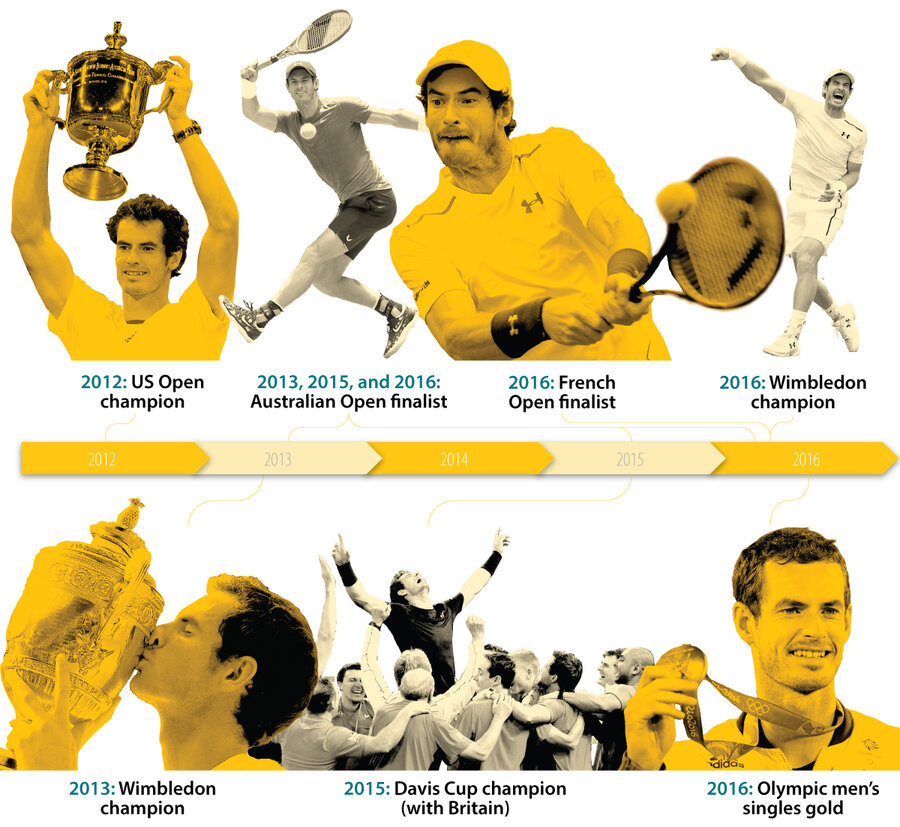A man in a time of legends, Andy Murray fought for his spot in the pantheon
Loading...
| San Antonio
It had been 76 years since a British man won Wimbledon. But that isn’t what makes Andy Murray perhaps the greatest British athlete of this century. It’s that even at his best, he often wasn’t good enough. And the fact that he may be this century’s greatest British athlete, but just its fourth greatest male tennis player, is just so very British. I grew up watching Tim Henman, which is to say I grew up watching him lose in the Wimbledon semifinals every year. Even as it became clear that Andy Murray was much, much better at tennis – reaching four Grand Slam finals and five semifinals between 2008 and 2012, losing each time to either Roger Federer, Rafael Nadal, or Novak Djokovic – it was hard to see if even he could do anything to end seven decades of British tennis futility. Enduring pain without complaint seems to have become core to British identity. That has been a central theme not only through Murray’s career but through his life. He was 9, and walking to the gym, when a gunman opened fire at Dunblane Primary School, killing 16 children and one teacher in the deadliest mass shooting in modern British history. At 17 he had a split patella he was told would prevent him from playing high-level tennis. He fought through it, as he did through everything else.
Why We Wrote This
As impressive as the championships are, the defeats are just as significant. Andy Murray is a human able to touch the heavens through sheer force of will.
My mother has a Union Jack flag that she keeps just inside the front door of her house. It’s old and faded, slightly tattered. My grandmother flew it outside her house on V-E Day in 1945. My mother also puts it out on special occasions – like when Andy Murray won Wimbledon in 2013.
Murray lost in the first round of the Australian Open Monday, in five sets to Spaniard Roberto Bautista Agut, in what may have been his last match. He said last week he hopes to play at Wimbledon one last time.
I’ve never been a chest-thumping patriot, or a tennis fanatic. Wimbledon is special, though – and it had been 76 years. Not even the V-E Day flag had seen a British man win Wimbledon.
Why We Wrote This
As impressive as the championships are, the defeats are just as significant. Andy Murray is a human able to touch the heavens through sheer force of will.
But that isn’t what makes Andy Murray perhaps the greatest British athlete of this century. It’s that even at his best, he often wasn’t good enough. And the fact that he may be this century’s greatest British athlete, but just its fourth greatest male tennis player, is just so very British.
Lots of British stereotypes are overblown. America has a higher per capita interest in the royal family, I’d wager, though Brits like the days off for weddings. But the pessimism, often thinly disguised as self-deprecation? The feeling, deep in the bones, that things can always get worse? That is true.
In sports this has manifested as an almost inevitable crumbling under pressure, an innate ability to snatch defeat from the jaws of victory. The England soccer team has long been the chief architect of this phenomenon, but for a long time so were British men at Wimbledon.
I grew up watching Tim Henman, which is to say I grew up watching him lose in the Wimbledon semifinals every year. Even as it became clear that Murray was much, much better at tennis – reaching four Grand Slam finals and five semifinals between 2008 and 2012, losing each time to either Roger Federer, Rafael Nadal or Novak Djokovic – it was hard to see if even he could do anything to end seven decades of British tennis futility.
Enduring pain without complaint seems to have become core to British identity.
That has been a central theme not only through Murray’s career but through his life. (He was 9, and walking to the gym, when a gunman opened fire at Dunblane Primary School, killing 16 children and one teacher in the deadliest mass shooting in modern British history.)
Early in his career he was seen as brusque, cold, and angry. He was British in victory and Scottish in defeat. As the Grand Slam final and semifinal losses mounted, so did the pressure. After losing to Federer in the 2012 Wimbledon final, he cried through the post-match interview. Suddenly he wasn’t a tennis robot. He was a human.
“Everybody always talks about the pressure, playing at Wimbledon, how tough it is. But it’s not the people watching, they make it so much easier to play. The support’s been incredible,” he said.
Public opinion turned, and so did his game. A month later he played Federer again, on Wimbledon’s Centre Court again, and beat him to win Olympic gold. Four years of consistent excellence followed. He finished 2016 as the world No. 1.
He is the first man to win consecutive Olympic singles golds. Only Fred Perry, the last British man to win Wimbledon, won more Grand Slams in the past 100 years – at a time, as my mother points out, when men played in trousers.
But as impressive as the championships are – the Davis Cup, which Murray won for his team almost single-handed, deserves special mention – the defeats are just as significant. The peak of his career coincided with Djokovic winning a record-equaling six Australian Open titles and a Federer resurgence. A series of deep runs in the clay court French Open ended at the hands of Nadal, probably the greatest clay court player ever.
He was knighted at the end of December 2016 for “services to tennis and charity.” A hip injury in 2017 hampered his performance, despite surgery in January 2018.
“I’ve been in a lot of pain for, well it’s been probably about 20 months now,” he said during an emotional press conference last week.
“I said to my team, ‘Look, I think I can get through this until Wimbledon.’ That’s when I would like to, that’s where I would like to stop playing,” he continued, “but I’m also not certain I’m able to do that.”
The appreciations have poured in since then.
Tennis legend Billie Jean King paid tribute to Murray’s advocacy for equality in tennis.
“You are a champion on and off the court,” King tweeted. “Your greatest impact on the world may be yet to come. Your voice for equality will inspire future generations.”
Murray has said he didn’t give much thought to feminism when he became one of the first top male players to hire a female coach, Amélie Mauresmo, in 2014. But the backlash the appointment provoked made him one. He became an outspoken critic of the gender pay gap in tennis and has repeatedly called out journalists for overlooking the achievements of female players.
At 31, some might think he is calling it quits prematurely. But he never had Federer’s effortless skill, Nadal’s ferocious power, or Djokovic’s potent combination of the two.
Instead, a consensus is emerging that Murray was a human who, in an era of gods, was able to touch the heavens through sheer force of will. His three Grand Slam titles trail, by a distance, Federer (20), Nadal (17), and Djokovic (14) – though he would probably point out that all four of them trail Serena Williams’s 23. To stay in that company, writes Jonathan Liew in The Independent, “perhaps it was no surprise, in retrospect, that he eventually broke himself trying.”
Researching this, I learned that Murray has a long injury history. I knew about the hip trouble, and back pain in 2013. I didn’t know that at 17 he had a serious knee injury he was told would prevent him from playing high-level tennis.
He fought through it, as he did through everything else.
I hope he is able to get the Wimbledon send-off he deserves. I’m sure my grandmother’s flag will be out for it.










